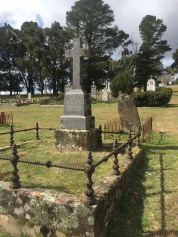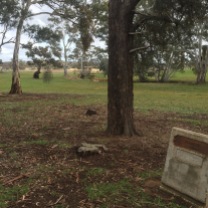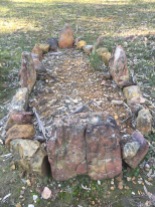The land around here is ancient. About 480 million years ago it was all under the sea. Then a couple of tectonic plates collided deep underground, squeezing everything like a vice.

I love the idea of sitting on the top of Tarrengower reading the story, as told by Justice B Nelson, and published by Culture Victoria, of two feuding volcanoes named Tarrengower and Lalgambook (Mount Franklin)
“A long, long time ago, long before anyone but the Traditional People walked our Country, our lands, rivers, mountains and animals alike, all had magical life. They had personalities, purpose, speech and they could think for themselves.
Tarrengower in the Dja Dja Wurrung means to be big and heavy and indeed he was just that; big, bold, wise and a very proud old volcano who had become very tired throwing out rocks and lava and preferred to sit humbly watching over the plains.
Another volcano called Lalgambook was a young, loud and cheeky volcano that started to challenge old Tarrengower’s wisdom and authority, and began grumbling and building up anger towards the old volcano. But Tarrengower, being the wise old volcano that he was, decided he should just try to ignore this cheeky little volcano.
Lalgambook grew even angrier that Tarrengower wasn’t acknowledging his threats and started to put on a display of smoke, ash and brimstone to impress the land and animals who were also watching, but this didn’t intimidate the wise old Tarrengower. Instead he just laughed at Lalgambook.
Lalgambook became so frustrated that he began to throw large rocks at Tarrengower who grumbled with annoyance at this cheeky volcano and Tarrengower now began to taunt young Lalgambook by telling him he wasn’t very strong at all because the rocks couldn’t reach him.
Lalgambook exploded with great fury, spurting out lava and smoke high into the sky and hurled gart gart in Tarrengower’s direction, but still could not reach him. This caused Lalgambook to completely blow his core!
Tarrengower’s anger eased and he just grumbled at this cheeky little volcano who was now just coughing and spluttering with no energy left at all.
All the rocks thrown by Lalgambook at Tarrengower can still be seen today and have formed what is known in the present day as the Guilford Plateau where the Jaara people would perform ceremonies on the Bora grounds also known as Yapene.”
Re-told by Justice B Nelson – Dja Dja Wurrung, Jaara
Content in Culture Victoria is free for educational use.
Copyright of this story
The writers, photographers and the State of Victoria
 In Game of Thrones men have maintained a watch on the wall for thousands of years. The fire tower on top of Mount Tarrengower has been consistently manned by firespotters, long term occupants of the tower, since the days of Oliver Ralph in the 1950’s. Most recently Peter Skilbeck has been on the watch!
In Game of Thrones men have maintained a watch on the wall for thousands of years. The fire tower on top of Mount Tarrengower has been consistently manned by firespotters, long term occupants of the tower, since the days of Oliver Ralph in the 1950’s. Most recently Peter Skilbeck has been on the watch!
The Advance Maldon Association brought the tower that stand on the top of Mount Tarrengower from Bendigo to Maldon to attract visitors to the area after the goldmining had almost ceased. The tower was originally the poppet legs of the Comet Mine in Bendigo, and was brought to Maldon by rail in 80′ (24m) lengths. It was carried up the mountain on a timber jinker drawn by a team of horses, along a track cut from Butts Reserve to the summit. A Mr. William Adams put up the money for the project, approx. 600 pounds. During the Maldon Easter Fair, held annually since 1877, the lookout tower is illuminated. Prior to the 1950s, this was done by wiring up over 100 makeshift lanterns, using stone ginger beer bottles, hemp wicks and kerosene. The bottles were hidden in a disused mine shaft until the next Easter.
Source: Fire Lookouts Downunder
The viewing distance from this tower is up to 100 km in all directions, except northwards to Bendigo and Mount Alexander where it is about 30 km.
Take the time to visit Mount Tarrengower and the cheeky younger volcano across the way. Learn about the spirits of volcano’s and draw upon their energy.
Volcano Folklore:
Land of Volcanoes
Merapi Volcano Spirit Keeper
Volcano Eruption Myth
Volcano Folklore
This page is only meant for educational use!

 This is a time when we can unleash and play with the Sacred Fool. The fool is a great rebel, able to thwart conventions and tell the truth without restraint.
This is a time when we can unleash and play with the Sacred Fool. The fool is a great rebel, able to thwart conventions and tell the truth without restraint. Situated at the Loddon River Ford at Newstead, Antares Iron Art Garden is an established art and sculpture garden created by Roger McKindley.
Situated at the Loddon River Ford at Newstead, Antares Iron Art Garden is an established art and sculpture garden created by Roger McKindley.


 “The Arrernte word Awelye, from Central Australia, describes the interrelationship of everything; plant, animal, earth and language. Aboriginal knowledge about plants, animals, non-living things, spirit, economy, aesthetics, kin, responsibility and journeying bind types of information with one another.
“The Arrernte word Awelye, from Central Australia, describes the interrelationship of everything; plant, animal, earth and language. Aboriginal knowledge about plants, animals, non-living things, spirit, economy, aesthetics, kin, responsibility and journeying bind types of information with one another.






 Adjoining neighbours have both thanked me for creating this leafy space because they have both noticed the appearance of the superb fairy blue wrens, a bird that as
Adjoining neighbours have both thanked me for creating this leafy space because they have both noticed the appearance of the superb fairy blue wrens, a bird that as 
































 I am sure you remember the Choose Your Own Adventure books, where you’re chased by a tiger. You can escape it by leaping into the ocean 50 feet below (go to page 48) or face the tiger with your homemade slingshot (go to page 128).
I am sure you remember the Choose Your Own Adventure books, where you’re chased by a tiger. You can escape it by leaping into the ocean 50 feet below (go to page 48) or face the tiger with your homemade slingshot (go to page 128).

















 An African proverb
An African proverb





































































 In Game of Thrones men have maintained a watch on the wall for thousands of years. The fire tower on top of Mount Tarrengower has been consistently manned by firespotters, long term occupants of the tower, since the days of Oliver Ralph in the 1950’s. Most recently Peter Skilbeck has been on the watch!
In Game of Thrones men have maintained a watch on the wall for thousands of years. The fire tower on top of Mount Tarrengower has been consistently manned by firespotters, long term occupants of the tower, since the days of Oliver Ralph in the 1950’s. Most recently Peter Skilbeck has been on the watch!













 The other stone, not far from the isolated Catholic Ground is inscribed with the words “A tribute to those who lay beneath may they have found peace”. After substantial rainfall this part of the world is truly beautiful. With only the sound of nearby grazing sheep I think it is a good place to lie and rest.
The other stone, not far from the isolated Catholic Ground is inscribed with the words “A tribute to those who lay beneath may they have found peace”. After substantial rainfall this part of the world is truly beautiful. With only the sound of nearby grazing sheep I think it is a good place to lie and rest.





 So you can imagine my delight when I finally found the Fryerstown cemetery. A Cemetery may not be on everyone’s list of top 10 places to visit but this one is particularly special. I thought that it would be a great place to take morning or afternoon tea in a picnic basket. It was there that
So you can imagine my delight when I finally found the Fryerstown cemetery. A Cemetery may not be on everyone’s list of top 10 places to visit but this one is particularly special. I thought that it would be a great place to take morning or afternoon tea in a picnic basket. It was there that




